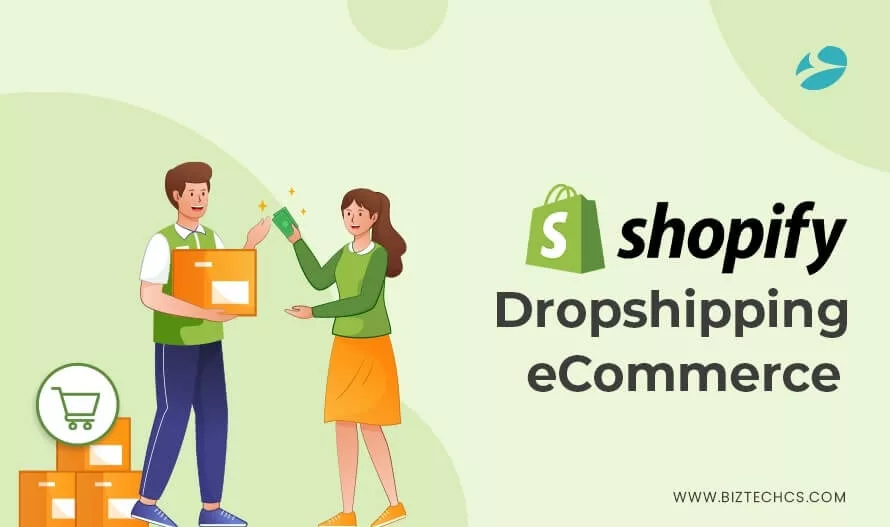Complete Guide To Shopify Dropshipping: Maximize Your eCommerce Potential
26 Sep, 2023
7 min read
26 Sep, 2023
7 min read
Table of Content:

If you’re eager to explore the dynamic world of eCommerce and want to build a thriving online business, you’ve come to the right place. Today’s blog post is all about overcoming the most critical challenges eCommerce businesses face with inventory management – with the help of Dropshipping.
Dropshipping solves several challenges that traditional retail and eCommerce models often fail to solve. It has revolutionized the way entrepreneurs enter the eCommerce arena, and Shopify stands as one of the most powerful platforms to kickstart your journey.
So without further ado, let’s learn about the ins and outs of Shopify Dropshipping in 2023. A reputed Shopify development company can further help you out with the technical aspects.
But before that, let’s learn how Dropshipping can help your business!
Dropshipping is an e-commerce business model where online store owners don’t have to worry about inventory storage or shipping. Instead, they focus on marketing and selling products to potential customers.
When a store owner receives an order from a customer, they simply contact the supplier, who will then ship the products directly to the customer’s door.
One of the key features of dropshipping is its difference from the traditional retail model. In the battle of dropshipping vs eCommerce, dropshipping gives businesses a lot of flexibility and cost-affordability.
Traditional retail store owners purchase different types of products in bulk from wholesalers or manufacturers, store them in warehouses, and then sell them to customers.
With dropshipping, store owners don’t need to invest in inventory upfront. This significantly reduces the startup costs and allows for a low-risk venture.
The benefits of dropshipping go beyond just low startup costs. Since there is no need for inventory storage, store owners can easily scale their online businesses. They can add new products to their online stores without any hassle and test different product ideas with minimal risk.
Additionally, store owners have the flexibility to manage their online stores from anywhere with an internet connection, making it a perfect option for entrepreneurs who are looking for location independence.
To sum up, eCommerce dropshipping offers a convenient and cost-effective way for aspiring entrepreneurs to start their online businesses.
There are several dropshipping pros that can help elevate your business performance and earn customer loyalty.
Shopify is a leading multinational e-commerce platform that empowers entrepreneurs to easily launch and manage their own online store. With its user-friendly interface and powerful features, Shopify makes it seamless for anyone to start selling and shipping their products to customers around the world.
With an intuitive drag-and-drop design interface, anyone can construct a visually appealing yet professional-looking online store; even without coding proficiency. Its integrated payment system, real-time analytics, and seamless integration with eCommerce marketplaces make it a desirable eCommerce platform.
Furthermore, Shopify is highly scalable, meaning it can support businesses of all sizes – from startups to large enterprises. It offers a wide range of customizable themes and apps, allowing users to expand and enhance their online stores as their business grows.
Shopify is a reliable and user-friendly e-commerce platform that simplifies the process of setting up and managing an online store.
One of the most interesting features you can use with this platform is dropshipping Shopify products directly to your customers. Let’s further explore why Shopify for small businesses is the best choice for your dropshipping needs.
Shopify has become one of the most popular ecommerce platforms for dropshipping businesses, thanks to its user-friendly interface and extensive range of features. With Shopify, aspiring entrepreneurs can easily set up and manage their online stores without any technical knowledge or coding skills.
Dropshipping with Shopify becomes seamless with the presence of a variety of plugins to enhance the functionality of the store, optimize conversions, and improve the overall customer experience.
1. Shopify is Drop shipper Friendly
Shopify is widely regarded as one of the most dropshipper-friendly ecommerce platforms available. It offers a host of features and benefits that make it an ideal choice for anyone looking to start a successful dropshipping business.
Even newcomers to the world of online business can easily navigate the platform and set up their own dropshipping store. Shopify’s intuitive design makes it simple to import products, manage inventory, and customize your online store.
2. Shopify Has a Host of Design Features
Shopify offers a host of design features that make it an ideal platform for dropshipping stores. One of the standout features is the availability of customizable themes. With a wide range of themes to choose from, entrepreneurs can select a design that aligns with their brand identity and target audience.
Its drag-and-drop website builders can design their store layout, add and rearrange elements, and create a seamless browsing experience for their potential customers.
By leveraging these design features on Shopify, dropshipping store owners can enhance the visual appeal of their online stores, making them visually engaging and attractive to potential customers
3. Shopify Boasts a Diverse App Ecosystem
Shopify offers a range of built-in dropshipping apps that can streamline your business operations. These apps automate tasks such as order processing, inventory management, marketing, and customer support saving you time and effort. Furthermore, Shopify seamlessly integrates with various ecommerce platforms, providing you with the flexibility to sell your products in multiple online stores.
4. Shopify Dropshipping Integration
Many dropshipping apps and integrations are available for Shopify, simplifying the process of importing products, managing suppliers, and automating order fulfillment.
5. Exceptional Customer Service with Shopify
Customer satisfaction is vital for a successful dropshipping business, and Shopify understands this. The platform offers excellent customer service tools, allowing you to provide exceptional support to your customers. Utilizing features like live chat, email marketing, and social media integration ensures that you can establish and maintain a loyal customer base. Shopify offers round-the-clock customer support via phone, email, and live chat to assist with any issues you encounter.
6. Shopify’s Seamless Payment Gateway Integration
It offers seamless integration with multiple payment gateways, making it easy for customers to make secure online payments.
7. Simplified Dropshipping Process
Shopify seamlessly integrates with various dropshipping apps, making it effortless to import products from reliable suppliers. With Shopify’s inventory management system, you can easily keep track of your stock and fulfill orders efficiently. Furthermore, its shipping integration provides real-time shipping rates, ensuring accurate calculations for your customers and reducing abandoned carts.
8. Effective Marketing Strategies
Shopify provides a wide selection of marketing tools to promote your dropshipping store. From content marketing to SEO optimization, you can easily attract potential customers and increase conversion rates. Additionally, Shopify’s integration with social media platforms enables you to leverage the power of social media marketing, further expanding your reach.
When it comes to drop shipping, there are certain items that you should not include in your product catalog. These items may either be prohibited due to legal restrictions or present safety concerns. It is important to be aware of these restrictions to ensure a smooth and compliant business operation.
Here are a few prohibited items you should be wary of including in your product catalog!
By carefully considering the items you choose to dropship, you can prevent potential legal issues and protect your customers. It is important to keep in mind that certain items may be restricted by the platform or marketplace you are using to run your dropshipping business.
P.S: Always research and abide by the guidelines set by your eCommerce platform to ensure a successful and compliant dropshipping journey.
Starting a dropshipping business can be an exciting and lucrative venture for aspiring entrepreneurs. With the right strategy and execution, you can build a profitable online business with minimal upfront investment and inventory management.
So let’s walk you through the detailed steps right from identifying your target market and finding reliable suppliers to optimizing your website and implementing effective marketing strategies for drop shipping Shopify.
1. Select a Dropshipping Idea
When it comes to selecting a profitable dropshipping business idea, it’s crucial to find a niche that resonates with your target audience and has the potential to attract potential customers. It can be Dog bow ties, iPhone cases, exercise equipment, camping gear, handcrafted items, or anything else.
Make sure your business idea is feasible and the products can be easily acquired from multiple vendors. It is preferable if you don’t have to rely on a single supplier for the products.
2. Find reliable dropshipping suppliers and manage inventory
Finding reputable dropshipping suppliers is essential for a successful dropshipping business. Shopify offers integrations with various dropshipping apps and platforms to help you discover trustworthy suppliers and automate your inventory management. Select suppliers that offer high-quality products, competitive pricing, and efficient shipping times to ensure customer satisfaction.
3. Do Competitive Research
Competitive research is an essential step in building a successful dropshipping business. By analyzing your competitors, you can gain valuable insights, identify market trends, and discover opportunities for improvement. Here’s how to conduct competitive research effectively:
Make sure to add these points when you create your Shopify checklist for competitive research.
4. Request an EIN Number for Your Business
Requesting an Employer Identification Number (EIN) for your dropshipping business is a crucial step in ensuring tax compliance and legal operations. To obtain an EIN, follow these simple steps:
Having an EIN is vital for your dropshipping business, as it enables you to report taxes, open a business bank account, hire employees, and comply with legal requirements. Ensure you request an EIN number early in your business journey to avoid any delays or complications with your tax obligations.
5. Financial Management
When starting a Shopify dropshipping business, it’s crucial to get your finances in order from the get-go. Effectively managing your finances will not only help you stay organized but also help make informed business decisions.
With a methodical approach to financial management, you can monitor your cash flow, track expenses, and identify areas for improvement in your Shopify dropshipping business.
6. Collect sales tax
Collecting sales tax is an essential aspect of running a dropshipping business. Complying with sales tax regulations is crucial as it ensures that your dropshipping store stays in line with the law and avoids any legal issues. Additionally, managing sales tax properly can help you maintain trust with your customers and build a reputable brand.
When you are using Shopify as your ecommerce platform, setting up sales tax collection is relatively straightforward. Shopify provides built-in tools that can assist you in configuring tax settings, determining tax rates, and generating tax reports.
7. Get a Local business licenses
Obtaining the necessary local business licenses is a vital step when starting a dropshipping business. It ensures that you are operating legally and in compliance with local regulations. These licenses and permits not only provide you with the legal right to operate, but also instill trust and confidence in your potential customers.
To obtain local business licenses for your dropshipping business, start by researching the specific requirements in your industry and location.
P.S.: Different industries may have different licensing requirements, so it’s important to understand what applies to your business.
8. Market Your Dropshipping Store
Implement effective marketing strategies to reach and engage with your target audience. You can adopt multiple marketing strategies such as Paid Ads, social media marketing, email marketing, and influencer marketing.
By incorporating these marketing strategies, you can effectively promote your dropshipping store, attract potential customers, and improve your conversion rates. Remember to constantly monitor and analyze your marketing efforts to optimize your campaigns and drive business growth.
Want to try dropshipping with any other eCommerce platform? You can also try drop shipping with Magento, Wix, WooCommerce, BigCommerce, and PrestaShop.
Unsure which eCommerce platform would be best for your online store? Read our detailed Magento vs Shopify comparison guide and pick the best platform for your eCommerce business.
With Shopify’s simplified and user-friendly platform, entrepreneurs can focus on their dropshipping business instead of overthinking technical aspects. By utilizing the excellent tools and features provided by Shopify, you can create an exceptional customer experience, drive sales, and build a successful dropshipping business.
So, why overcomplicate things when you can choose Shopify for a hassle-free path to entrepreneurial success?
While this comprehensive guide informs you of the ins and outs of dropshipping with Shopify, you also get to explore the detailed steps of working with the platform. In case you encounter any issues with the steps or need technical assistance, our specialized Shopify developers can help you out in this pursuit.
Reach out to us and discuss how we can help with your Shopify dropshipping idea!

Artificial Intelligence (AI)
23
By Biztech Editor
24 Dec, 2025

Odoo
25
By Uttam Jain
24 Dec, 2025

Artificial Intelligence (AI)
38
By Biztech Editor
23 Dec, 2025